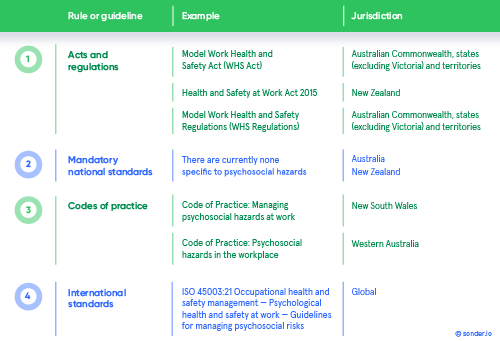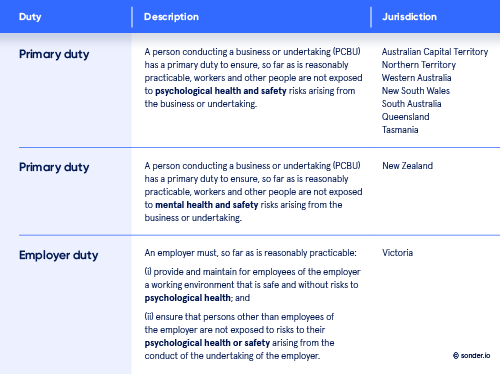A year after the release of ISO 45003 shone a spotlight on psychological safety, it’s time to review what’s changed in the legislation and guidance material in Australia since we published our original ISO 45003 guide. But first, let’s recap why psychological safety and the global ISO 45003 standard are important.
This post will cover:
- What is psychological safety?
- Why is psychological safety important?
- What is ISO 45003?
- Why is ISO 45003 important?
- What psychological safety rules have changed in Australia in 2022?
- Workplace Health and Safety (WHS) in Australia and New Zealand (updated August 2022)
- Jurisdictional duty
What is psychological safety?
Psychological safety “is the ability to show and employ oneself without fear of negative consequences of self-image, status, or career (Kahn 1990, p.708). In psychologically-safe teams, team members feel accepted and respected”.
Why is psychological safety important?
Psychological safety is important for employee wellbeing, recruitment, retention, productivity, innovation, brand reputation, and organisational resilience.
Positive outcomes for employees
- Greater wellbeing at work
- Motivation to perform well
- Clear role clarity and better workload balance
- Peace of mind that work is a safe place
- Diverse and collaborative environment
- Sense of pride in the workplace
- Improved health and health behaviours
- Enhanced job satisfaction
- Increased job productivity
- Less need for workers’ compensation
- Supportive environment for speaking up
- Decreased inclination to quit
Positive outcomes for organisations
- High employee wellbeing rates
- Engaged and high performing workforce
- Reduced performance management and retraining
- Safe and inclusive working environment
- Greater idea sharing and innovation
- Enhanced reputation and ability to attract talent
- Reduced absenteeism and presenteeism
- High retention and lowered recruitment costs
- Improved productivity and work/product quality
- Reduction of workers’ compensation claims
- Less workplace investigations and litigation
- Strengthened organisational resilience
What is ISO 45003?
ISO 45003 is the first global standard that provides specific guidance on the management of psychosocial hazards and risks, and the promotion of wellbeing at work, in a manner consistent with other health and safety risks in the workplace.
At its core, ISO 45003, officially known as ISO 45003:21 Occupational health and safety management — Psychological health and safety at work — Guidelines for managing psychosocial risks, is a risk management tool to help organisations in their shared responsibility to build safer and healthier workplaces.
Why is ISO 45003 important?
ISO 45003 represents an important step toward employee wellbeing because it expands the traditional workplace focus on physical health and safety to consider the equally important workplace need for psychological health and safety.

What psychological safety rules have changed in Australia in 2022?
There have been several recent developments in the legislation and guidance material in Australia relating to psychological safety, including:
- The commencement of the Work Health and Safety Act 2020 (WA) on 31 March 2022;
- The commencement of the Code of Practice: Psychosocial hazards in the workplace in Western Australia on 11 February 2022;
- The changes to the Model WHS Regulations to introduce psychosocial hazards (see commentary here); and
- Victoria’s draft proposed Occupational Health and Safety Amendment (Psychological Health) Regulations.
Workplace Health and Safety (WHS) in Australia and New Zealand (updated August 2022)
There are four primary levels of regulations and guidelines across Australia and New Zealand:
Level 1: WHS Legislation
The strongest of these is the first level, which is enforceable by law and comprises the WHS Act and WHS Regulations in Australia, and the Health and Safety at Work Act 2015 in New Zealand. The Australian rules came as a result of a 2009 National Review into Model Occupational Health and Safety Laws, which led the Commonwealth, Territories and States (except for Victoria) to adopt the Model Work Health and Safety Act (WHS Act) and the Model Work Health and Safety Regulations (WHS Regulations). The WHS Laws in each jurisdiction are therefore broadly the same (subject to minor variations). New Zealand’s Health and Safety at Work Act 2015 was based in part on Australia’s Model WHS Act (subject to some variations).
Level 2: Mandatory national standards
In a limited number of circumstances, WHS regulations mandate compliance with particular national standards or at least parts of them. This means that failure to comply with that standard can amount to a breach of the applicable WHS law.
Level 3: Codes of practice
The WHS Act authorises the Ministers in each jurisdiction to approve a code of practice. Codes of practice should be followed and can be used by safety regulators in a prosecution as evidence of steps that could or should have been taken to comply with the law.
Level 4: International standards
International standards such as ISO 45003 – set by the International Organization for Standardization (ISO) – provide guidance for how to comply with duties under WHS laws, but they are not enforceable unless compliance is specifically mandated in WHS regulations. However, regulators looking for evidence of compliance with legislation may reflect on the observance of recommendations in guidance documents, and organisations may choose to mandate compliance as part of a contractual requirement.
For more information, we invite you to download our updated guide, A simple overview of ISO 45003.

Jurisdictional duty
Jurisdictional duty is the legal term for the authority granted to a legal entity to enact justice.
In May 2021, NSW implemented the Code of Practice: Managing psychosocial hazards at work. By doing so, they became the first AU/NZ jurisdiction to implement an approved code of practice addressing psychosocial hazards. In February 2022, Western Australia implemented the Code of Practice: Psychosocial hazards in the workplace.
On 14 April 2022 (following the meeting of Australia’s ministers responsible for work health and safety), psychosocial hazards were added into a new division 11 of the Model WHS Regulations. Although the Model Regulations are not enforceable at a Commonwealth, state or territory level, the changes are expected to be enacted in each of the states and territories across Australia.
For jurisdictions without a code of practice for managing psychosocial hazards in the workplace, standards such as ISO 45003 provide a useful guide to assist organisations to comply with their duties under WHS laws.
These duties vary slightly between the different jurisdictions, and each workplace will have a unique way of dealing with psychosocial hazards that is particular to the context and content of the work.

Want to learn more?
For more information about how Sonder can help you rethink your student and/or employee support, we invite you to contact us here.
For more information about ISO 45003, we invite you to download our must-read guide here.
About Sonder
Sonder is a technology company that helps organisations improve the wellbeing of their people so they perform at their best. Our mobile app provides immediate, 24/7 support from a team of safety, medical, and mental health professionals – plus onsite help for time-sensitive scenarios. Accredited by the Australian Council on Healthcare Standards (ACHS), our platform gives leaders the insights they need to act on tomorrow’s wellbeing challenges today.



